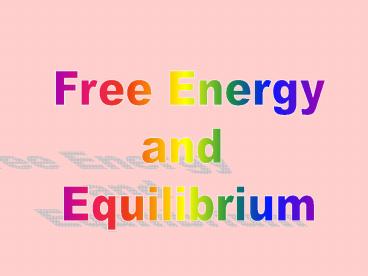Free Energy - PowerPoint PPT Presentation
1 / 15
Title:
Free Energy
Description:
When components of a reaction are mixed, they will proceed, rapidly or slowly (depending on kinetics) to the equilibrium position. Equilibrium position: defined as ... – PowerPoint PPT presentation
Number of Views:35
Avg rating:3.0/5.0
Title: Free Energy
1
Free Energy and Equilibrium
2
- When components of a reaction are mixed, they
will proceed, rapidly or slowly (depending on
kinetics) to the equilibrium position. - Equilibrium position defined as the point at
which forward and reverse reaction rates are
equal (Chapter 13). - Thermodynamics point of view equilibrium point
occurs at the lowest value of free energy
available to the reaction system.
3
- Consider the simple reaction below
- A(g) ? B(g)
- where 1.0 mole of gaseous A is placed in a
reaction vessel at a pressure of 2.0 atm. - Total free energy of system
- GTotal GA GB
- Figure (a) illustrates the initial free energies
of A and B.
4
- As A changes to B, GA will decrease because PA is
decreasing (b). - GB will increase because PB is increasing.
- Reaction will proceed to right (products) as long
as GTotal decreases (GB is less than GA). - At some point the pressures of A and B reach the
values such as GA is equal to GB.
5
- The system is at equilibrium and has reached
minimum free energy (c). - No longer driving force to change A to B or B to
A, so system remains at this position and
pressures of A and B remain constant.
6
- A(g) ? B(g) 1.0 mol A(g) at 2.0 atm
- Plot of free energy versus the mole fraction of A
is shown in (a) below. - Minimum free energy is reached when 75 of A has
been changed to B. - At this point, the pressure of A is 0.25 times
the original pressure or - (0.25)(2.0 atm) 0.50 atm
- Pressure of B is
- (0.75)(2.0 atm) 1.5 atm
7
- K (equilibrium constant) can be calculated using
equilibrium pressures - Overall free energy curve is shown in (c).
- This demonstrates any mixture of A(g) and B(g)
containing 1.0 mol (A plus B) at a total pressure
of 2.0 atm will react until it reaches the
minimum in the curve.
8
- In summary,
- Reactions proceed to minimum free energy
(equilibrium) - Corresponds to the point where
- Gproducts Greactants
- or
- ?G Gproducts Greactants 0
9
- Remember,
- ?G ?Go RT ln(Q)
- At equilibrium, ?G equals 0 and Q K.
- So ?G 0 ?Go RT ln(K)
- Or ?Go -RT ln(K)
10
- ?Go -RT ln(K)
- Case 1 ?Go 0.
- When ?Go 0 the free energies of reactants and
products are equal when all components are in
standard states (1 atm for gases). - System is at equilibrium when the pressures of
all reactants and products are 1 atm, which means
K 1.
11
- ?Go -RT ln(K)
- Case 2 ?Go lt 0.
- ?Go (Goproducts Goreactants) is negative
- Goproducts lt Goreactants
- System is not at equilibrium and system will
adjust to the right to reach equilibrium. - K will be greater than 1 (pressures of products
at equilibrium are greater than pressures of
reactants).
12
- ?Go -RT ln(K)
- Case 3 ?Go gt 0.
- ?Go (Goproducts Goreactants) is positive
- Goreactantslt Goproducts
- System will not be at equilibrium and system will
adjust to the left to reach equilibrium. - K will be less than 1(pressure of the reactants
will be greater than 1 atm and the pressure of
the products will be less than 1 atm).
13
- Cases 1, 2 and 3 are summarized in Table 16.6.
- The value of K for a specific reaction can be
calculated from the equation - ?Go -RT ln(K).
14
Free Energy and Work
- The maximum possible useful work obtainable from
a process at constant temperature and pressure is
equal to the change in free energy. - Free energy is energy free to do work.
- wmax ?G
- The amount of work obtained is always less than
the maximum.
15
- Henry Bents First Two Laws of Thermodynamics
- First law You cant win, you can only break
even - Second law You cant break even
- Read this section in the book!!!!!!!!!!!!



















![Energy is FREE - Like the AIR that you breathe [File 2 (or 1) of 5] PowerPoint PPT Presentation](https://s3.amazonaws.com/images.powershow.com/9270442.th0.jpg?_=20190520017)











